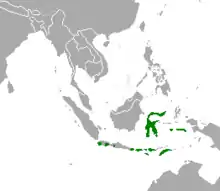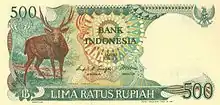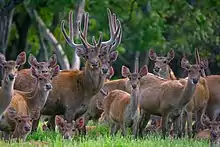Javan rusa
The Javan rusa or Sunda sambar (Rusa timorensis) is a deer native to Indonesia and East Timor. Introduced populations exist in a wide variety of locations in the Southern Hemisphere.
| Javan rusa | |
|---|---|
.jpg.webp) | |
| Male and female at Baluran National Park, East Java, Indonesia | |
| Scientific classification | |
| Kingdom: | Animalia |
| Phylum: | Chordata |
| Class: | Mammalia |
| Order: | Artiodactyla |
| Family: | Cervidae |
| Subfamily: | Cervinae |
| Genus: | Rusa |
| Species: | R. timorensis[2] |
| Binomial name | |
| Rusa timorensis[2] (Blainville, 1822) | |
 | |
| Present distribution within the native range, including possible ancient introductions | |
| Synonyms | |
|
List
| |
Taxonomy

Seven subspecies of the Javan rusa are recognised:[2]
- R. t. timorensis (Timor rusa deer) – Timor.
- R. t. djonga – Muna and Butung Islands.
- R. t. floresiensis (Flores rusa deer) – Flores and other islands.
- R. t. macassaricus (Celebes rusa deer) – Celebes.
- R. t. moluccensis (Moluccan rusa deer) – Molucca Islands.
- R. t. renschi – Bali.
- R. t. russa (Javan rusa deer) – Java.
Characteristics
The Javan rusa is dark blackish brown and has a grey forehead. Its back is almost black, the underparts and inner thighs are yellowish brown. The abdomen is lighter brown, and the tail tuft is dark blackish brown. The hair is coarse and longer on the chest than on the remaining body. Its ears are wide and a little shorter than the head. The antlers are medium long and rather wide, the upper branch points forward.[3] Fawns are born without spots. Males are bigger than females; head-to-body length varies from 142 to 185 cm (4.66 to 6.07 ft), with a 20 cm (7.9 in) tail. Males weigh 152–160 kg (335–353 lb), female about 74 kg (163 lb).[4]
Distribution and habitat

The Javan rusa natively occurs on the islands of Java, Bali, and Timor in Indonesia. It has been introduced to Irian Jaya, Borneo (Kalimantan), the Lesser Sunda Islands, Maluku, Sulawesi, Pohnpei, Mauritius, Reunion, Fiji, Tonga, Samoa, Vanuatu, the Solomon Islands, the Christmas Islands, the Cocos Islands, Nauru, Australia, New Caledonia, New Zealand, Papua New Guinea, New Britain, and New Ireland.[1][5] Rusa deer were introduced by the Dutch to New Guinea during the early 1900s.[6]:375
Ecology
Rusa deer are active mostly in the early morning and late afternoon. They are rarely seen in the open and are very difficult to approach due to their keen senses and cautious instincts.
The species is very sociable, and individuals are rarely found alone. When alarmed, a rusa stag lets out an extremely loud honk. This is an alarm call and alerts any other deer in the vicinity.
As with other deer species, Javan rusa mainly feed on grass, leaves, and fallen fruit. They do not drink water, deriving all required fluid from their food.[7][4]
Predators
The main predators of the Javan rusa include the Javan leopard, the dhole, crocodiles, pythons, and the Komodo dragon on the islands of Rinca, Komodo, and Flores.[7][4]
Reproduction
The Javan rusa mates around July and August, when stags contest by calling in a loud, shrill bark and duelling with the antlers. The doe gives birth to one or two calves after a gestation period of 8 months, at the start of spring. Calves are weaned at 6–8 months, and sexual maturity is attained at 3–5 years, depending on habitat conditions. Javan rusas live 15–20 years both in the wild and in captivity.[7][4]
References
- Hedges, S.; Duckworth, J.W.; Timmins, R.J.; Semiadi, G. & Dryden, G. (2015). "Rusa timorensis". IUCN Red List of Threatened Species. 2015: e.T41789A22156866.
- Grubb, P. (2005). "Species Rusa timorensis". In Wilson, D.E.; Reeder, D.M (eds.). Mammal Species of the World: A Taxonomic and Geographic Reference (3rd ed.). Johns Hopkins University Press. p. 670. ISBN 978-0-8018-8221-0. OCLC 62265494.
- Fitzinger, L. J. (1875). "Kritische Untersuchungen über die Arten der natürlichen Familie der Hirsche (Cervi). II. Abtheilung". Sitzungsberichte der Kaiserlichen Akademie der Wissenschaften. Mathematisch-Naturwissenschaftliche Classe. 70: 239–333.
- "Rusa, Sunda sambar". Ultimate Ungulate.
- Long, JL (2003). Introduced Mammals of the World: Their History, Distribution and Influence. Cabi Publishing. ISBN 9780851997483.
- Georges, A., Guarino, F., & Bito, B. (2006). Freshwater turtles of the TransFly region of Papua New Guinea – notes on diversity, distribution, reproduction, harvest and trade. Wildlife Research, 33(5), 373. doi:10.1071/wr05087
- Reyes, E. "Rusa timorensis". University of Michigan Museum of Zoology. Animal Diversity Web.
External links
| Wikimedia Commons has media related to Rusa timorensis. |
| Wikispecies has information related to Rusa timorensis. |
- "Rusa deer". Animalia.
- "Rusa timorensis". Museum of Zoology. Animal Diversity Web. University of Michigan.
- "Feral rusa deer". Department of Agriculture and Fisheries. Restricted invasive animals. Queensland Government, Australia. 18 May 2020. Retrieved 2020-06-27.

